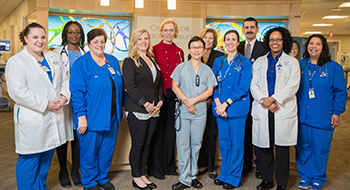New care model aims to beat the statistics for hip fracture patients

Members of the hip fracture oversight committee include (l-r): Megan Webb, RN; Olukemi Akande, MD; Julie Torello, RN; Brooke Spadaccino, RN; Mary O'Connor, MD; Jinlei Li, MD; Carol Just, RN; Francesca DiRobbio, RN; John Tarutis; Charlene Campbell, APRN; and Jessica Schoen, RN
Each year, more than 300,000 people 65 and older in the U.S. are hospitalized for hip fractures. After surgery, many of these patients need nursing home care, and about 20 percent of all U.S. hip-fracture patients die within a year, according to the Centers for Disease Control and Prevention.
A team with the Center for Musculoskeletal Care at Yale New Haven Hospital is working to change that, implementing a clinical redesign project designed to improve these patients' outcomes.
Previously, patients who came to YNHH emergency departments with a broken hip were admitted to whichever nursing units could accommodate them, at either campus. Patients were given opioid pain medication until they had surgery to repair the fracture, which might not happen for 48 hours.
In fall 2015, Mary O'Connor, MD, director, Center for Musculoskeletal Care, YNHH and Yale School of Medicine, convened a hip fracture team of orthopedic physicians, hospitalists, nurses, physical and occupational therapists and staff from other disciplines. The team developed a project to change the care model for hip fracture patients.
"Previously, these patients were often viewed as "add-ons" and not prioritized in terms of surgical care," Dr. O'Connor said. "Our goal is to ensure they receive the integrated care they need from the start, because they can develop complications beyond the fracture itself. Our new approach is truly a team effort."
Surgical care is equally shared between Yale Medicine faculty and community orthopedic surgeons, and Jensa Morris, MD, hospitalist, leads medical optimization efforts, Dr. O'Connor said.
Under the new hip-fracture care model, which launched at the SRC in February 2016:
- First responders bring most hip fracture patients to the Saint Raphael Campus, which houses musculoskeletal operating rooms and Center for Musculoskeletal Care inpatient units.
- In the ED or in the hospital room, patients receive a nerve block injection that lasts 12 to 16 hours, versus multiple doses of opioid pain medication, which can cause constipation, delirium, kidney issues and other concerns.
- One of the musculoskeletal ORs is dedicated to hip fracture patients with a goal of getting patients into surgery within 24 hours of admission.
- After surgery, patients go to one of the musculoskeletal inpatient units.
- Whenever possible, physical and occupational therapists get these patients out of bed the day of surgery and begin rehabilitation as soon as possible.
The team has already seen improvement; the average length of stay for a hip fracture patient dropped from 5.1 days in 2015 to 4.5 days from February - July 2016.
“It’s a work in progress,” said Megan Webb, RN, clinical outcomes leader, Center for Musculoskeletal Care Unit (Verdi 4 North). She noted that the hip fracture team meets monthly to review research and best practices on other components of care for hip fracture patients, including reducing surgical-site infections and preventing future falls.
“Our team is fabulous, great to work with and totally committed to improving care for these patients,” Dr. O’Connor said. “This has been such a rewarding project, as we continue to improve outcomes for this special population in our community.”
